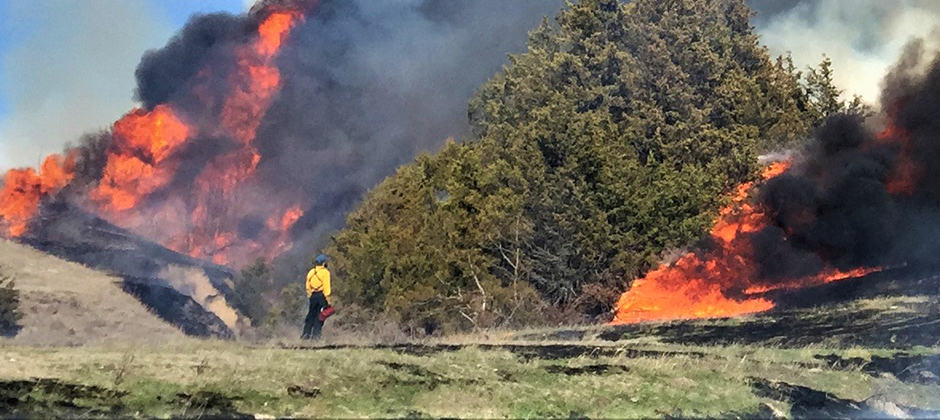Share this article
For grassland birds, the prescription is fire
Prescribed burns in the Great Plains have helped grassland birds to return to the area.
Birds like northern bobwhite quail (Colinus virginianus), greater prairie-chickens (Tympanuchus cupido) and ring-necked pheasants (Phasianus colchicus) are facing declines as a result of habitat loss, agriculture, energy development and urbanization. Another important factor in their declines is a lack of fire that stops woody encroachment into their grassland habitats.
“Grassland birds are in a tight spot,” said Caleb Roberts, an assistant unit leader with the U.S. Geological Survey’s Arkansas Cooperative Fish and Wildlife Research Unit. “Essentially, trees and big shrubs are displacing grasslands.”
Historically, fire kept trees at bay and maintained the grasslands. Roberts and his colleagues wanted to know if they could boost the diversity of grassland bird species by returning fire closer to its historical role.
Roberts led a study published in Ecological Solutions and Evidence looking work by private ranchers, natural resource agencies and researchers using prescribed fires in the Loess Canyons ecoregion of Nebraska. A team of about 50 people, working on what they call the Loess Canyons Experimental Fire Landscape, set out in their personal vehicles, ate breakfast together, burned all day, then came back to eat dinner together. When it comes to setting fires, “they’re wizzes,” Roberts said.
The team implemented large, intense fires—not quite as big as they once burned naturally, but as large as safety precautions allowed. “They’re returning fire, not on the historical scale obviously, but a scale large enough to produce results at an ecoregion scale, which is incredible,” Roberts said.
To see how large-scale fire treatments impacted bird life, Roberts and his colleagues analyzed these burns alongside data from the North American Breeding Bird Survey and data on tree coverage in the region. They found that when fires killed more trees, the number of grassland bird species increased. In more than 65% of the Loess Canyons area—about 90,000 hectares or 222,000 acres—grassland bird richness increased with the fires.
“We’ve had trouble finding any example of a restoration action in grasslands at this sort of scale,” he said. Other taxa, like the threatened American burying beetle (Nicrophorus americanus) and native plants, have benefitted, too.
The group is continuing its efforts, using satellite imagery to hone its efforts. Public fears about fire remain, but with the success of efforts like this one, Roberts said, evidence is mounting for wider use of big, hot fires for restoring grasslands throughout the Great Plains.
Header Image: Prescribed fires in the Loess Canyons ecoregion of the Great Plains helped increase grassland bird species richness. Credit: Caleb Roberts








